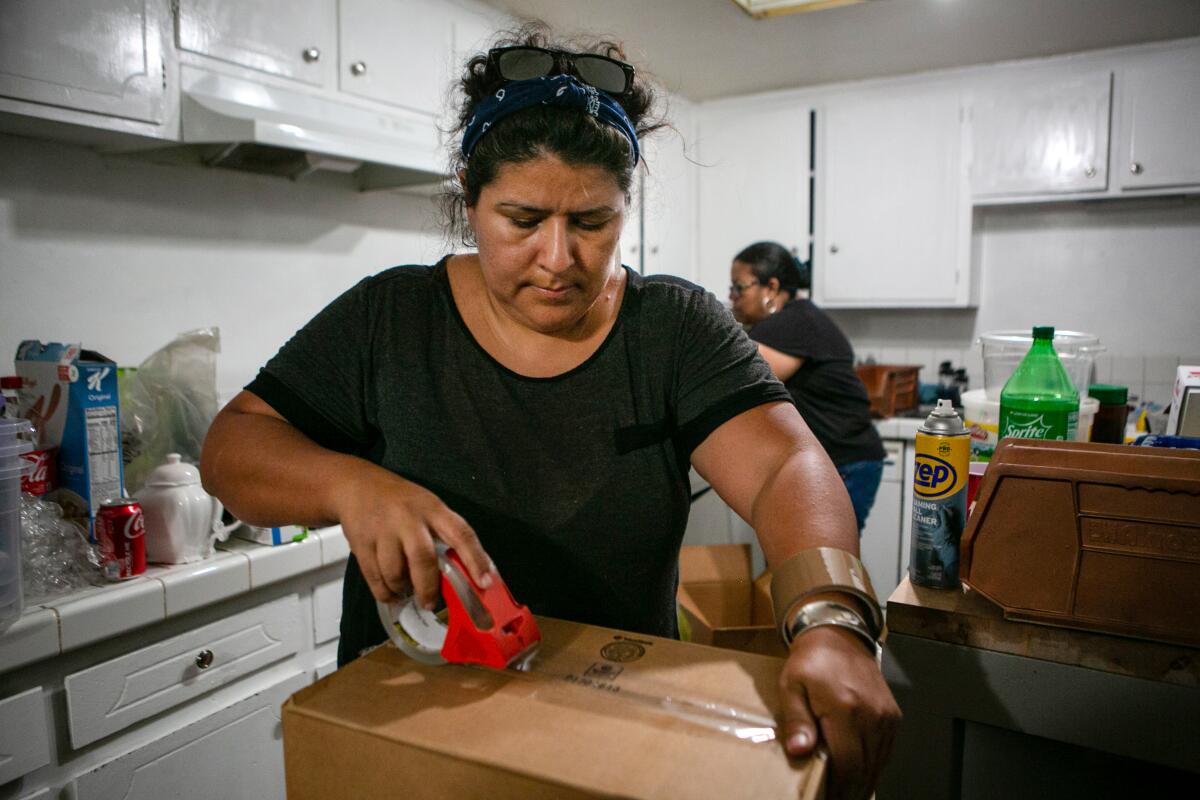California population keeps falling, led by coastal losses; inland areas keep growing

- Share via
California’s population continued to decline after falling for the first time on record during the COVID-19 pandemic — but that loss is showing signs of slowing, new demographic data indicate.
The state’s population declined by 117,552 between Jan. 1, 2021, and Jan. 1, 2022, bringing the estimated total population to 39,185,605, according to data released by the state Department of Finance on Monday. The 0.3% decline represents a slowing compared with the 0.59% drop over the nine-month period between the April 2020 census date and that year’s end, demographers said.
The continued dip underscores shifting immigration patterns, declining birthrates and the large number of deaths due to the pandemic. A growing number of families have moved inland over the last few years, data show, but the migratory shift grew even more pronounced as the barriers to moving dropped for many in large cities, spurred by a newfound ability to work remotely.
California’s most populous counties saw sizable declines in population during the first year of the pandemic, census data show, highlighting how the state’s housing crisis and other demographic forces are reshaping two of its largest cities.
Demographers noted the first population decline ever recorded in the state last year, highlighting larger trends that recently led to the loss of a congressional seat. But there is no evidence of a “CalExodus,” said Walter Schwarm, chief demographer with the Department of Finance.
“To a certain extent, we have two or three things happening here — the pandemic is there in the sense that natural increase, it really slowed down over these two years. Some of that is a lack of births because of delayed childbearing decisions,” Schwarm said. “Things are getting a little better, fertility is coming back after the pandemic.”
COVID-19-related deaths, federal policies restricting immigration and an increase in domestic out-migration also affected population totals, the Department of Finance said.
“Overall growth was also affected by continuing federal delays in processing foreign migration: while last year saw positive immigration (43,300), the level was below the average annual rate of 140,000 before the pandemic,” the department said in a statement.
Population growth remained strong in the interior counties of the Central Valley and the Inland Empire as Californians in search of more open space, a sense of community and affordable housing continued to trade city life in major urban centers like the Bay Area or Los Angeles for suburban and rural communities.
“California led in housing price increases for a number of months compared to other metro areas,” Schwarm said. “That alone provides a heavy impetus for people who were maybe on the fence to move.”
The shift inland, Schwarm said, also reflects an uptick in people who work for companies that offer remote or hybrid work.
“They’re willing to do a longer commute one or twice a month, or week, to have something different in an off-the-coast community where things are less dense and housing types are different,” he said.
The majority of counties in the state saw declines, data show, including every coastal county except San Luis Obispo, Santa Barbara and Santa Cruz. That limited coastal growth is due in part to college students returning to campus, demographers said.
Riverside and San Bernardino counties saw population gains as California overall lost nearly 262,000 residents between July 2020 and July 2021.
Only two counties showed more than 1% growth: Yolo, due to increases in college group quarters including dorms, and San Benito, because of housing gains. At the same time, 34 of the state’s 58 counties lost population. The biggest drops occurred in Plumas, Lassen, Butte, Del Norte, Napa, San Mateo, Marin, Shasta, San Francisco and Ventura.
California’s three most populous counties, meanwhile, all experienced population loss: Los Angeles lost 70,114 people, San Diego lost 1,197 and Orange lost 7,297. Of the 10 largest cities in California, Bakersfield had the largest percentage gain in population at 0.7%, followed by San Diego at 0.2%.
Melissa R. Michelson, a political science professor at Menlo College in Atherton, Calif., called housing prices “the perennial answer to things happening in California.”
“Our housing is in such a crisis that even facing very long commutes and knowing that gas prices aren’t going down anytime soon, people are choosing to move inland,” said Michelson, who is dean of arts and sciences at the Silicon Valley college.
Like Schwarm, she pointed to remote work as one of the reasons Californians are moving inland.
“Where I work in Silicon Valley, professors have to go back to work. But some of the staff are working remotely and lots of people who work for Silicon Valley companies like Apple and Twitter are given the option to work remotely,” she said.
“If you’re a programmer or working at a startup — especially because here you’re working in teams with people in India and in Israel — what difference does it make if they are in office in Menlo Park or at their home office?”
Dowell Myers, a professor of policy, planning and demography at USC, said this shift in California’s population is part of a larger trend that began in 2015.
“Millennials are getting older, and they need more space,” he said. “They’re partnering up, and even without kids they want more space and to buy homes if possible. That’s long been underway.”
On top of that, he said, the pandemic decimated urban amenities such as nightlife and prevented many people from using public services that made city life attractive.
“People wanted to live in the city because that’s where the action was,” he said. “When you close down all the action and people aren’t riding transit like they used to, you’re not really anchored.”
The decline has been particularly noticeable during the pandemic because whereas people once moved inland gradually, large groups began to move all at once, fed up with dealing with multiple roommates while trying to work, or trying to find a quiet space to take a Zoom meeting in a small apartment.
“People are aiming for the suburbs,” Myers said. “The pandemic was a trigger they all jumped.”
More to Read
Sign up for Essential California
The most important California stories and recommendations in your inbox every morning.
You may occasionally receive promotional content from the Los Angeles Times.











